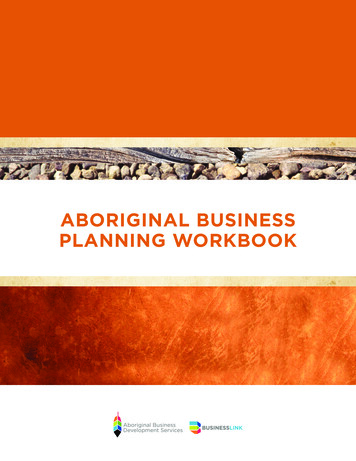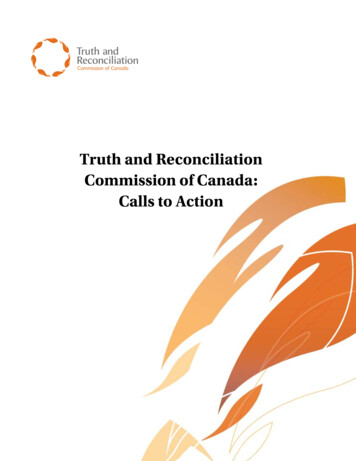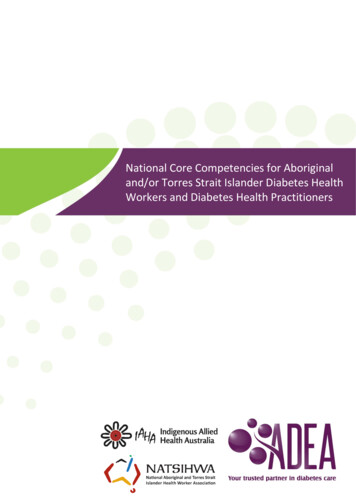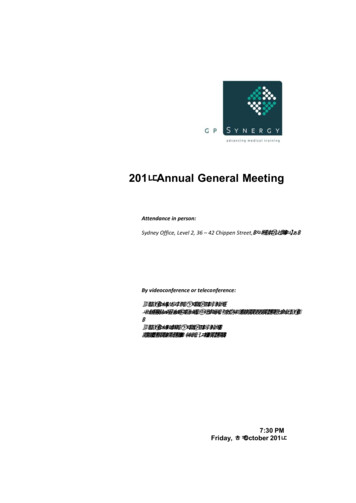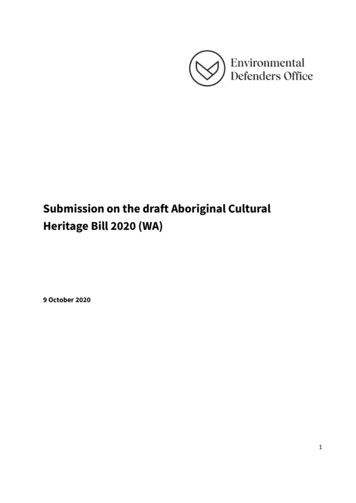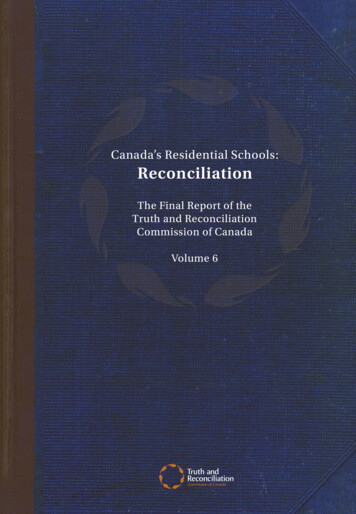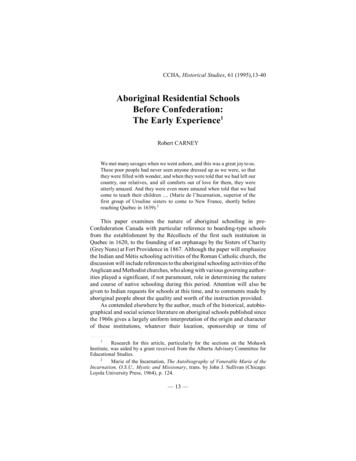
Transcription
CCHA, Historical Studies, 61 (1995),13-40Aboriginal Residential SchoolsBefore Confederation:The Early Experience1Robert CARNEYWe met many savages when we went ashore, and this was a great joy to us.These poor people had never seen anyone dressed up as we were, so thatthey were filled with wonder, and when they were told that we had left ourcountry, our relatives, and all comforts out of love for them, they wereutterly amazed. And they were even more amazed when told that we hadcome to teach their children . (Marie de l’Incarnation, superior of thefirst group of Ursuline sisters to come to New France, shortly beforereaching Quebec in 1639).2This paper examines the nature of aboriginal schooling in preConfederation Canada with particular reference to boarding-type schoolsfrom the establishment by the Récollects of the first such institution inQuebec in 1620, to the founding of an orphanage by the Sisters of Charity(Grey Nuns) at Fort Providence in 1867. Although the paper will emphasizethe Indian and Métis schooling activities of the Roman Catholic church, thediscussion will include references to the aboriginal schooling activities of theAnglican and Methodist churches, who along with various governing authorities played a significant, if not paramount, role in determining the natureand course of native schooling during this period. Attention will also begiven to Indian requests for schools at this time, and to comments made byaboriginal people about the quality and worth of the instruction provided.As contended elsewhere by the author, much of the historical, autobiographical and social science literature on aboriginal schools published sincethe 1960s gives a largely uniform interpretation of the origin and characterof these institutions, whatever their location, sponsorship or time of1Research for this article, particularly for the sections on the MohawkInstitute, was aided by a grant received from the Alberta Advisory Committee forEducational Studies.2Marie of the Incarnation, The Autobiography of Venerable Marie of theIncarnation, O.S.U., Mystic and Missionary, trans. by John J. Sullivan (Chicago:Loyola University Press, 1964), p. 124.— 13 —
operation. Much of this literature suggests that a majority of school-age FirstNations children who attended school from the early seventeenth centuryonwards, went to boarding schools, that they went to these institutionsunwillingly, usually without the consent of their parents and were forciblykept there for years on end. According to these accounts, the conditions ofIndian residential schools, which in certain areas also enrolled Métis andsome Inuit and white children, were not only foreign to the pupils’ religiousand cultural beliefs, but also involved care and teaching arrangements whichhad little to do with their after school lives.3Criticisms of aboriginal residential schools also abound in recent mediareports,4 representations before the Royal Commission on AboriginalPeoples,5 studies by the Assembly of First Nations (AFN),6 and personal3R. Carney, “The Grey Nuns and the Children of Holy Angels: FortChipewyan and Fort Resolution 1874-1924,” in The Uncovered Past: Roots ofNorthern Alberta Societies. R. McCormack and R. Ironside ed., CircumpolarResearch series No. 3 (Edmonton: Canadian Circumpolar Institute, University ofAlberta, 1993), pp. 105-125.4The following productions, broadcast recently on television and much usedin other instructional contexts, typify the negative assessments made about residentialschools by the print and visual media: Northern Native Broadcasting “Mission SchoolSyndrome,” 1988 (release date 1993); The Fifth Estate, CBC, “Violation of Trust,”January 9 1991; and Anglican Church of Canada, “Search for Healing: AnglicanResidential Schools Revisited,” 1992.5In 1993, George Erasmus, co-chairman of the Royal Commission onAboriginal Peoples, summed up the submissions made before the Commissionconcerning residential schools as follows: “Everywhere we have gone, we have beentold about the impact of residential schools . Most of the stories we are hearing arenegative; 99% of them.” Quoted in Assembly of First Nations, “Breaking TheSilence: An Interpretative Study of Residential School Impact and Healing asIllustrated by the Stories of First Nations Individuals” (Ottawa: AFN, 1994), p. 3.Cited hereafter as “Breaking The Silence.”6“Breaking The Silence” is the most recent major study on this topicsponsored by the AFN. Other unpublished material produced by the Assembly on thistopic includes a “Literature Review of Residential Schooling” (Ottawa: AFN, FirstNations Health Commission, n.d.), pp. 1-17; and “Residential Schools Survey onSurvivors of Child Abuse and Deprivation of Language and Culture ThroughAssimilation” (Ottawa: AFN, National Lobbying Committee on Residential Schools,1994), pp. 1-40.— 14 —
narratives7 and meetings of former students.8 Instances of sexual, physicaland emotional abuse of boarding pupils are given prominence in thesesources, and are often cited as the primary reason for the present distress offormer students. Much of the research and subsequent selection of data forwhat is said, which invariably reflects negatively on those who operated suchschools, has been based on secondary sources, on interpretations ofgovernment and missionary documents and, to an increasing extent, on theoral and written testimony of former students.Most of the above sources give cursory or, at best, partial attention toaboriginal schooling prior to Confederation. Moreover in so doing, theyinvariably select only that material which supports current criticisms ofpost-Confederation boarding schools. As a result many of these sources arelacking in at least one of three respects. In the first instance, they do not havethe scope, sequence and depth needed to understand the nature of aboriginalschooling before 1867. Secondly these sources assume aboriginal schoolingcontinuities between the pre- and post-Confederation periods where noneexisted, and thirdly they fail to recognize continuities which, in fact, werethere. In identifying and interpreting those largely ignored aspects of thepre-1867 aboriginal schooling continuum, this paper intends to give anoverall account of what occurred, and why it did.A recent example of the reluctance to give a comprehensive picture ofpre-1867 aboriginal schooling, or to call for further research on this period– at least as an informed prelude to what happened following Confederation– can be found in an unpublished 1994 Assembly of First Nations (AFN)study entitled “Literature Review on Residential Schooling.”9 The AFNdocument finds fault with most of the thirty odd Canadian-focused studieschosen for review not because of their overall conclusions, which are invariably critical of aboriginal schooling regardless of when or where it occurred,but rather because their conclusions lack the intensity and validity which oral7The extensive list of published personal narratives in which the authors arecritical of their time in residential schools begins with Harold Cardinal's "The UnjustSociety" (Edmonton: M.G. Hurtig, 1969) and continues to the present with suchworks as I. Knockwood's "Out of the Depths: The Experiences of Mi'Kaw Childrenat the Indian Residential School at Shubenacadie, Nova Scotia" (Lockport, NovaScotia, 1992). These publications contrast markedly with earlier and more favourableaccounts of these schools such as J. Gladstone's "Indian School Days," AlbertaHistorical Review, 15(1), pp. 18-24.8Meetings of former students held to discuss their experiences in schoolresidences are recent occurrences. For examples of two such events, see press reportsof reunions held at Fort Albany (St. Anne’s) in 1992 Globe and Mail November 11,1992 p. A-7, and at Chesterfield Inlet (Turquetil Hall) in 1993 The EdmontonJournal, October 11, 1994 pp. Al and 9.9“Literature Review of Residential Schooling” (Ottawa: First NationsHealth Commission, n.d.).— 15 —
and written “native testimony”10 would give them. One cannot quarrel withthe latter assertion, nor dispute the document’s concluding reference to theneed for “co-operative research efforts between non-native and native people[which] would provide an opportunity for a blending of voices in harmoniouscollaboration.”11 Such collaboration, however, should not result in a uniformassessment of pre-1867 aboriginal schooling, nor should it require that theoutcomes of examining the continuities and discontinuities of such schoolingbe predetermined by the prevailing view of this phenomenon. What followstherefore should be seen as part of the collaborative exercise called for in theAFN’s “Literature Review.” In addition to examining aboriginal schoolingcontinuities and discontinuities prior to Confederation, the narrative willprovide a basis for locating and evaluating aboriginal schooling afterConfederation.An example of the continuing influence that is not generally recognizedin contemporary references to aboriginal schooling in the nineteenth andtwentieth centuries concerns the important role that colonial educationalagencies had on all aspects of aboriginal day and residential schooling.Egerton Ryerson, who served as Ontario’s chief superintendent of schoolsfrom the 1840s to the 1870s, outlined an Indian educational policy in 1847which affirmed that Indians should be schooled in separate, denominational,boarding, English-only and agriculturally-oriented (industrial) institutions.Although Indian schooling was separated constitutionally and administratively after Confederation from the rapidly developing system of public(common) schooling in Ontario, and from its counterparts in Manitoba andthe Northwest Territories, the influence of public schooling practices andpolicies on aboriginal schooling continued unabated throughout the periodof mission-operated Indian schools. This was particularly so in mattersrelating to staff, curriculum and institutional arrangements which publicschoolmen believed should characterize the schooling provided native children, even though they were not held responsible for what ensued.12An example of a discontinuity is the often held assumption that Jesuitand Ursuline Indian residential schools of the seventeenth century continuedto exist into the nineteenth century.13 The fact is that both congregations haddecided to abandon such institutions by 1700. One reason for their doing so10Ibid, p. 1.Ibid, p. 13.12For a discussion of this influence in the Northwest Territories, see R.Carney, “Residential Schooling at Fort Chipewyan and Fort Resolution 1874-1974,”in Études Oblates de l’Ouest!Western Oblate Studies, 2ed. R. Huel,(Lewiston, N.Y.:Edwin Mellen Press, 1992), pp. 115-138.13See, for example, Linda R. Bull, “Indian Residential Schooling: The NativePerspective,” Canadian Journal of Native Education, vol. 18 (1991 supplement), pp.1-64.11— 16 —
was the overwhelming Amerindian resistance to such schools. The Anglicanand Methodist churches and new state agencies were chiefly instrumental forrestoring the aboriginal residential school concept in early nineteenth-century Canada, and for implementing custodial and instructional arrangements in such institutions which persisted well into the next century.Although the continuities and discontinuities, such as those mentionedabove, are central to this examination of pre-1867 aboriginal schooling, theyrepresent only part of the history of native schooling prior to Confederation.As references to specific aboriginal schooling initiatives, they will notnormally entail direct comparisons with the state-aided grammar andcommon (public) schools of the time. Some comment will now be madeabout them however, not only because of their inferiority in terms oftwentieth century schooling standards, but also because they influenced thenature of aboriginal day and residential schooling during the period of study.The favoured type of schooling for non-aboriginal children was thatprovided by the grammar schools, which were funded in 1807 when thegovernment of Upper Canada passed its first educational act authorizing 400 apiece to eight grammar schools. Located in district centres, operatedunder the auspices of the Church of England and governed by appointeeschosen from the colony’s elite, they charged high fees and followed anacademic, classical curriculum for small numbers of elementary andsecondary pupils. With the exception of Upper Canada College, they neverbecame the upper class schools envisaged by John Graves Simcoe, thecolony’s first governor, who wanted them to be like the great public boardingschools of England. Needless to say, the facilities and programs provided inthe grammar schools were less than those at Eton or Harrow. The boarders,who brought their own “beds, beddings, towels, and silver spoons,” wereoften crowded into the masters’ houses, and sometimes attended class inrented spaces in jails, taverns, courthouses and temperance halls. Of thefourteen such institutions in operation in the mid-1850s, ten had a singleteacher and four but two.14 Early accounts of these male only schools describelittle more than their spartan atmosphere and rigorous discipline. But as PaulBennett indicates, bullying and homo-eroticism among students and publiccanings and sexual abuse of students by staff were “hushed up” byheadmasters who “blotted [such instances] from the official records.”15 Itwould appear that Indian children did not enroll in grammar schools untilthe 1860s. Since boarding arrangements in many of these institutions were14John Calam, “An Historical Survey of Boarding Schools and Public SchoolDormitories in Canada” (M.A. thesis, University of British Columbia, 1962), pp.22-25.15Paul W. Bennett, “Little Worlds: The Forging of Social Identities inOntario’s Protestant School Communities and Institutions, 1850-1930” (Ph.D. diss.,University of Toronto, 1990), pp. 24-25.— 17 —
no longer favoured by this time, the few Indian children who went to themdid so as day scholars.Many Euro-Canadian children never went to school throughout theperiod, and most of those who did went to common day schools. And asignificant number of these attended infrequently and for a few years only.Many teachers in the common schools, which grew apace during Ryerson’ssuperintendency, had little more than an elementary education, and most hadno prior preparation for teaching. Teachers’ complaints of overwork, poorsalaries and unruly pupils were largely ignored. As a result many left theirassignments for more remunerative or highly valued careers. Learningresources were scarce and the curriculum seldom took into account thelinguistic and cultural backgrounds of non Anglo-Saxon children.16 As wasthe case with the grammar schools, few Indian children enrolled in thecommon schools. This does not mean that aboriginal day and residentialschools were not influenced by the practices and conditions of their publiccounterparts.While comparisons of native and non-native schools contribute to agreater awareness of the differences and commonalities existing betweenthem, they tell only part of the story of these schools. Until the 1960s whenthe work of social historians like Bernard Bailyn gained prominence,17historians of education in Canada and the United States devoted themselvesalmost entirely to chronicling the rise of free, centralized, state-supported,non-denominational systems of public schooling in their respective countries.Other institutional arrangements, such as voluntary or religious schools,were either ignored or denigrated in their accounts; and they gave little morethan passing attention to more encompassing forms of enculturation, notablythose which took place in the household and workplace. Although Bailynand others played a significant role in changing the narrow, self-laudatoryapproach found in traditional school histories, they have had very littleinfluence upon the perspective of those who write about native schools. Asa result most accounts of aboriginal day and residential schools have giveninordinate attention to aspects of these institutions which reveal little ornothing about the social, economic and cultural background of the parents,16For a further analysis of the evolution of public schooling in Upper Canada,Rupert’s Land and the Northwest Territories, see the following articles by the author:“Going to School in Upper Canada,” in ed. E. Brian Titley Canadian Education:Historical Themes and Contemporary Issues (Calgary: Detselig Enterprises Ltd.,1990), pp. 9-44, pp. 189-195; and “Hostility Unmasked: Catholic Schooling inTerritorial Alberta,” in eds. N. Kach and K. Mazurek Exploring Our EducationalPast: Schooling in the Northwest Territories and Alberta (Calgary: DetseligEnterprises Ltd., 1992), pp. 17-36.17Bernard Bailyn, Education in the Forming of American Society (New York:Random House, 1960), p. 1.— 18 —
or of the children who went to school.It is not possible here to give a comprehensive picture of the effects thatchanging socio-economic conditions had on the lives of native people overthe first 250 years of Aboriginal-European contact. Suffice it to say that untilConfederation most native communities had not been subjected to what E.P.Patterson terms the reserve or third phase of Aboriginal-European contact.This phase did not begin in earnest until the signing of the Western Treatiesin the 1870s. Patterson describes the first period of contact as one in whichboth parties gained some benefit, particularly with respect to the exchangeof technologies, and the second as one in which Indians were drawn deeperinto the economies of newcomers, with a gradual loss of Indian autonomy ineconomic, spiritual and political matters.18 While the designation of reservelands for Indians was initially not too disruptive, it was not long until anumber of exclusionary measures made the aboriginal presence irrelevant tomainstream society.Although aboriginal schooling was part of this process in some instancesprior to 1867, schooling histories seldom recognized its minor role in theoverall process of Indian transformation. As the third or reserve phase ofAboriginal-European contact happened after Confederation, its relevance tothis discussion is to remind the reader that schooling, whenever or whereverit occurs, invariably reflects the socio-economic preferences of dominantgroups. Since schooling is also largely an idiosyncratic phenomenon, it isdifficult to determine its immediate or long term effects on the lives ofchildren. This and other considerations mentioned earlier need to be kept inmind in the following discussion on aboriginal schooling in New France,New Brunswick, Upper Canada (Canada West), Rupert’s Land and theNorthwestern Territory until the late 1860s. The discussion examines thevarious roles imperial and colonial administrations, and Anglican, Methodistand Roman Catholic churches took with respect to aboriginal schooling priorto the passage of the British North America Act in 1867, which assignedresponsibility for Indians and Indian lands to the federal government.New France18E. Palmer Patterson II, The Canadian Indian: A History Since 1500 (DonMills, Ontario: Collier-MacMillan Canada, Ltd., 1972). For a more thorough andup-to-date study of aboriginal people in Canada, see Olive Patricia Dickinson’sCanada’s First Nations: A History of Founding Peoples From Earliest Times(Toronto: McClelland & Stewart, 1992).— 19 —
The Jesuit Relations19 and the letters of Marie de l'Incarnation,20 foundress of the Ursuline convent at Quebec, provide telling accounts of Amerindian indifference and resistance to what the missionaries, as boardingschool teachers and child care givers, had to offer. Other religious communities, such as the Congregation of the Sisters of Notre Dame, who openedan orphanage at Ville Marie in 1657, also took in Indian as well as Frenchchildren, but only for a while. The Notre Dame Sisters and the SulpicianFathers opened day schools for Amerindian children at the Mission de laMontagne in 1677. The program of studies included Christian doctrine,French, plainsong and music, training in stonework, tailoring and shoemaking for the boys and domestic skills for the girls. Both ventures ended in1694, when the houses and church in the Indian village burned to theground. From then on, the Sulpicians and the Sisters of the Congregationwere not directly involved in Amerindian schooling.21 New religious sisterhoods, such as the Sisters of Charity of Montreal (the Grey Nuns) foundedin 1737 by Madame d’Youville, assumed a wide-ranging mandate foreverything from “helping the poor, the old, the invalid, the sick and mad [tocaring for] women prisoners, prostitutes and orphans.”22 But unlike theUrsulines or the Sisters of the Congregation, the Grey Nuns did not serve asteachers before coming to Rupert’s Land in 1844.The Grey Nuns’ work with orphans and foundlings is of special interestto this study. It was one of their primary activities in Montreal where, asPeter Moogk points out, illegitimate births among the colonial populationbecame an increasing problem in the eighteenth century, as did the practiceof giving these children to the Amerindians.23 Despite an intendant’s ordinance in 1722 which forbade assignments of this nature, it was common aslate as the 1750s to find illegitimate children of French colonists in ChristianIndian villages, where, according to Moogk, “they fully accepted theAborigines’ way of life.”24 The Grey Nuns provided an alternative care19The Jesuit Relations and Allied Documents Travels and Explorations of theJesuit Missionaries in New France 1610-1791, ed. R.G. Thwaites (Cleveland: TheBurrows Brothers Company, 1901), 73 vols.20Marie of the Incarnation, The Autobiography of Venerable Marie of theIncarnation, O.S.U., Mystic and Missionary, trans. John J. Sullivan (Chicago: LoyolaUniversity Press, 1964).21M. l’Abbé Roland L’Italien, Le Grand Séminaire de Montréal de 1840 à1990 (Montréal: Éditions du Grand Séminaire de Montréal, 1990), pp. 18-22.22Micheline Dumont et al, Quebec Women: A History (Toronto: TheWomen’s Press, 1987), p. 40.23Peter N. Moogk, “Les Petites Sauvages: The Children ofEighteenth-Century New France” in Childhood and Family in Canadian History, ed.J. Parr (Toronto: McClelland and Stewart, 1982), p. 27.24Ibid.— 20 —
arrangement, but the number of illegitimate children born to Canadienneswas such that the sisters had neither the resources nor, it would seem, thedesire to care for Amerindian children as well. James Axtell’s “The WhiteIndians of Colonial America” refers to the relationships between Englishcolonists and Indians, and his observations concerning the latter’s proficiency in educating their own children “without resorting to physicalcompulsion or emotional undercutting”25 can also be applied to the Amerindians of New France. That the French did not take Amerindian childreninto their homes or educational institutions undoubtedly had a positive side.The Amerindians followed their own forms of education, and the Frenchtheirs. This also meant, however, that religious sisterhoods like the GreyNuns and the Oblates of Mary Immaculate had little or no understanding ofIndian cultures, nor experience with Indian children, before assumingresponsibility for their care and formal education in the 1860s. They appearto have ignored former Amerindian responses to boarding schools when theyopened their own such schools in the 1860s.Some of the lessons learned by seventeenth century French missionariesconcerning the efficacy of aboriginal residential schools were apparentlyremembered by the Jesuits when they took up aboriginal schooling again inthe 1840s. They followed certain pedagogical principles in what could bedescribed as bush or wilderness schools. These principles included “tact,infinite patience and gentleness,” – in effect a rejection of the European ideaof childhood, “which always saw the man in the child” and which regardedchildhood “as a period of preparation, obedience, as discipline, often of aharsh character.”26 Jesuit instruction took place in or near some 125 missionsin Acadia and New France from 1611 to the death in 1800 of the lastmember of the Society of Jesus who stayed in New France after theconquest.27 Children attending wilderness classrooms were taught in smallgroups and in their own languages. A variety of pedagogical techniques wereused to support such instruction, including simulated games, rewards andprizes, songs and pictures. Little thought was given to imparting secularknowledge, though some of this must have happened given the instructionalcontext. The curriculum included prayers, hymn singing, devotions anddoctrine, which sometimes involved the teaching of written scripts. As wasthe case with the Micmac language in New Brunswick, some Amerindianlanguages were eventually written in Roman characters, but any hope of25James Axtell, The European and the Indian: Essays in the Ethnohistory ofColonial North America (New York: Oxford University Press, 1981), p. 168.26Roger Magnuson, “Jesuit Pedagogy and the Wilderness Classroom in17th-Century Canada,” Canadian Journal of Native Education, 17 (1), p. 72.27A. Melançon, S.J., “Missions des Jésuites Nouvelle France 1611-1800,”Jesuit Archives, Quebec City, 1925. Original copy of map in the author’s possession.— 21 —
making this orthography part of schooling there was thwarted with thecoming of British rule.New BrunswickProtestant entry into the mission fields of Acadia began in earnest in1796 when the New England Company, a London-based philanthropicsociety, established a number of Anglican Indian day schools around SaintJohn. There is no evidence that the Indians asked for these institutions. Theyhad hitherto shown no interest in European schooling and were of the samemind about this venture. The Company responded by consolidating its dayschool operations into a facility at Sussex Vale which was to be operated bya local board of commissioners. The plan was to settle Indian families onCompany land. Their children would be required to attend school on a daybasis, and once the children were old enough, they were to be apprenticed tolocal white settlers. As attendance at Sussex Vale was very irregular, stepswere taken in 1807 to provide twenty boarding places in the school, and tomaintain an equal number of day spaces for children who were to beindentured locally. The school’s residential program involved taking ininfant children, restricting contact with their families, and keeping themaway from Roman priests.28 Those who finished their apprenticeship were tobe settled on a Company estate where according to one of the localcommissioners, they would “form a distinct community of civilizedIndians.”29Of the fifty-five children who enrolled during the school’s first fifteenyears, none completed an apprenticeship or achieved a basic level of literacy.Such dismal results prompted the company to initiate inquiries into SussexVale’s problems in the 1820s. The reports of these investigations were highlycritical. Many children were apprenticed before reaching the age of seven.Masters often kept their charges from attending school and were remiss inproviding practical training. There were also reports that some sexuallyexploited their female apprentices. The chief beneficiaries of the Company’sendeavour were the masters themselves, who in addition to securing thechildren’s labour, also received 20 a year for sheltering each child.30Attempts by the London commissioners to turn the situation around were tono avail. As a result they abandoned the Sussex Vale project in 1826, having28J.W. Chalmers, Education Behind the Buckskin Curtain (Edmonton:University of Alberta, 1972), pp. 38-41.29Judith Fingard, “The New England Company and the New BrunswickIndians, A Comment on the Colonial Perversion of British Benevolence,” Acadiensis1, no. 2 (Spring 1972), p. 32.30Chalmers, Education Behind the Buckskin Curtain, (1972) p. 40.— 22 —
decided to start anew with a band of Mohawks who had settled along theGrand River in Upper Canada.Upper Canada (Canada West)In the late eighteenth century some 2,000 Iroquois led by Joseph Brant,Chief of an Anglican-influenced Mohawk band, came to Upper Canada aspart of the United Empire Loyalist migration. In 1761 when Brant was nineteen, he had attended Moor’s Indian Charity School in Connecticut where asa boarding pupil he studied the Bible, English, Latin, Greek and Mathematics. He later recalled this experience as follows, “Though I was anunprofitable pupil in some respects, yet my worldly affairs have been muchbenefited in the instruction there received .”31 The British militarysupported the resettlement of Brant’s group on the Grand River in UpperCanada by providing land and promising an allowance of 20 per annum fora teacher whom the Mohawks were to choose themselves.32 The Grand RiverMohawks opened several day schools, the first in 1786, which was conductedby their own schoolmasters who used Mohawk prayer books and primers.33Many of these ventures were short-lived however, partly because thepromised allowances were not forthcoming.A day school had opened in the Tuscarora village in 1819, but it closedsoon after when its Indian schoolmaster was “dismissed on serious moralcharges.”34 Situations such as this led to Mohawk representations to the NewEngland Company, which included an 1822 visit by Brant’s youngest son toLondon, where he obtained a promise of support for a school and apermanent Anglican mission in Grand River. No mention was made duringthe London meeting about a residential school. What Brant had in mind andpromised to put into effect was a day school program consisting of “plainreading and writing and accounts.”35 When the Company sent Robert Luggerto the area as the resident Anglican missionary in 1827, he immediately setabout establishing schools, the most important being t
Egerton Ryerson, who served as Ontario's chief superintendent of schools from the 1840s to the 1870s, outlined an Indian educational policy in 1847 which affir med that In dian s should be schooled in separ ate , de nomin atio nal, boarding, English-only and agriculturally-oriented (industrial) institutions.

